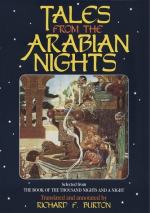[FN#167] Arab. “Ikhwan al-Safa,” a popular term for virtuous friends who perfectly love each other in all purity: it has also a mystic meaning. Some translate it “Brethren of Sincerity,” and hold this brotherhood to be Moslem Freemasons, a mere fancy (see the Mesnevi of Mr. Redhouse, Trubner 1881). There is a well-known Hindustani book of this name printed by Prof. Forbes in Persian character and translated by Platts and Eastwick.
[FN#168] Among Eastern men there are especial forms for “making brotherhood.” The “Munhbola-bhai” (mouth-named brother) of India is well-known. The intense “associativeness” of these races renders isolation terrible to them, and being defenceless in a wild state of society has special horrors. Hence the origin of Caste for which see Pilgrimage (i. 52). Moslems, however, cannot practise the African rite of drinking a few drops of each other’s blood. This, by the by, was also affected in Europe, as we see in the Gesta Romanoru, Tale lxvii., of the wise and foolish knights who “drew blood (to drink) from the right arm.”
[FN#169] The F. Sacer in India is called “Laghar” and tiercel “Jaghar.” Mr. T.E. Jordan (catalogue of Indian Birds, 1839) says it is rare; but I found it the contrary. According to Mr. R. Thompson it is flown at kites and antelope: in Sind it is used upon night-heron (nyctardea nycticorax), floriken or Hobara (Otis aurita), quail, partridge, curlew and sometimes hare: it gives excellent sport with crows but requires to be defended. Indian sportsmen, like ourselves, divide hawks into two orders: the “Siyah-chasm,” or black-eyed birds, long-winged and noble; the “Gulabi-chasm” or yellow-eyed (like the goshawk) round-winged and ignoble.
[FN#170] i.e. put themselves at thy mercy.
[FN#171] I have remarked (Pilgrimage iii.307) that all the popular ape-names in Arabic and Persian, Sa’adan, Maymun, Shadi, etc., express propitiousness—probably euphemistically applied to our “poor relation.”
[FN#172] The serpent does not “sting” nor does it “bite;” it strikes with the poison-teeth like a downward stab with a dagger. These fangs are always drawn by the jugglers but they grow again and thus many lives are lost. The popular way of extracting the crochets is to grasp the snake firmly behind the neck with one hand and with the other to tantalise it by offering and withdrawing a red rag. At last the animal is allowed to strike




